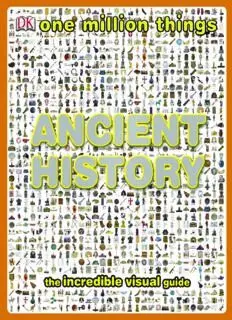
One Million Things: Ancient History PDF
Preview One Million Things: Ancient History
one million things A N C I E N T H I S TO R Y LONDON, NEW YORK, MELBOURNE, MUNICH, AND DELHI For Tall Tree Ltd: Editors Rob Colson, Jon Richards, and Jennifer Sanderson Designers Malcolm Parchment and Ed Simkins For DK Publishing: Senior editor Victoria Heyworth-Dunne Senior designer Phillip Letsu Managing editor Linda Esposito Managing art editor Jim Green Creative retouching Steve Willis Picture research Louise Thomas Category publisher Laura Buller DK picture researcher Emma Shepherd Production editor Andy Hilliard Senior production controller Angela Graef Jacket design Hazel Martin Jacket editor Matilda Gollon Design development manager Sophia M. Tampakopoulos Turner Development team Yumiko Tahata First published in the United States in 2011 by DK Publishing 375 Hudson Street New York, New York 10014 10 9 8 7 6 5 4 3 2 1 001—179075—June/11 Copyright © 2011 Dorling Kindersley Limited All rights reserved under International and Pan-American Copyright Conventions. No part of this publication may be reproduced, stored in a retrieval system, or transmitted in any form or by any means, electronic, mechanical, photocopying, recording, or otherwise, without the prior written permission of the copyright owner. Published in Great Britain by Dorling Kindersley Limited. DK books are available at special discounts when purchased in bulk for sales promotions, premiums, fund-raising, or educational use. For details, contact: DK Publishing Special Markets, 375 Hudson Street, New York, New York 10014 or [email protected]. A catalog record for this book is available from the Library of Congress. ISBN: 978-0-7566-8259-0 Printed and bound by Leo, China Discover more at www.dk.com one million things A N C I E N T H I S TO R Y Written by: Joe Fullman Consultant: Dr John Haywood 1 3 The Middle East Europe 6 42 Fertile crescent 8 Neolithic and Bronze First cities 10 Age Europe 44 Kings and empires 12 Minoans and Assyria vs. Babylon 14 Mycenaeans 46 Middle Eastern firsts 16 Greek city-states 48 Bible lands 18 The Greek world 50 The Phoenicians 20 Greek innovators 52 Persian Empire 22 Alexander the Great 54 The Spice Route 24 Rise of Rome 56 2 Roman Empire 58 Roman city life 60 Roman army 62 The ancient Celts 64 4 Africa 26 Ancient Egypt 28 Gift of the Nile 30 Gods of Egypt 32 Asia The afterlife 34 66 Nubia 36 Early Indian civilizations 68 Carthage 38 The Mauryan empire 70 Great Zimbabwe 40 The Gupta empire 72 Early Chinese The Incas 102 civilizations 74 The Inca world 104 The first emperor 76 The Pueblo people 106 The Chinese way 78 Mound builders 108 Ancient Korea 80 Native cultures of Ancient Japan 82 North America 110 6 Steppe nomads 84 5 The Pacific 112 The Americas 86 Australia 114 The Olmecs 88 The Pacific islands 116 The Maya 90 Easter Island 118 Teotihuacán and New Zealand 120 the Toltecs 92 The Aztecs 94 Timeline 122 The Aztec world 96 Glossary 124 Early South American Index 126 cultures 98 Acknowledgments 128 Moche and Nazca 100 Contents ISHTAR GATE This image of a lion once adorned the Processional Way in Babylon. Built in 575 BCE, the road linked the main entrance of the city, the Ishtar Gate, with the ziggurat temple of the chief Babylonian god, Marduk. 6 The Middle East 7 FERTILE CRESCENT A group of people that farms the land to create surpluses of food, lives in cities, has a society with a hierarchy, and is ruled by some form of Ti government is said to be a “civilization.” Civilizations emerged gradually gris at different times around the world. The first civilizations developed in tinh ea Mpliadcdel ec aEllaesdt, Mwehseorpe ofatarmmiian.g first began around 10,000 years ago, Euphrates Mesopotamia . HUNTER-GATHERERS Farming first started as a result of climate change at the end of the last ice age. Before that, people were hunter-gatherers, moving from place to place in search of food. However, the new weather conditions changed the previous distribution of plants, which people had been familiar with. It is believed that people began planting wild seeds and u THE FERTILE CRESCENT tubers as a way of guaranteeing their food supply. The Fertile Crescent, where the first farmers appeared around 10,000 years ago, is an area of land that stretches in an arc through parts of Bow, arrows, and a modern Israel, Lebanon, Syria, Turkey, and Iraq. gathering bag used There were two main factors that made this d CULTIVATION by prehistoric stretch of the Middle East ripe for agriculture: hunter-gatherers First, it had a climate with warm temperatures OF PLANTS and reliable rainfall. Second, it had a wide Early farming involved the range of plants and animals that were suitable simple gathering and planting for domestication. of wild seeds. The first crops to be cultivated on a significant scale were emmer wheat, einkorn wheat, barley, lentils, peas, bitter vetch, chickpeas, and flax. Together, these are known as the eight founder crops. Selective breeding of these plants allowed early farmers to produce bigger crops with a greater yield. Some of this food could be stored for later use. Selective breeding has Modern wheat created plump seeds u DOMESTICATION OF ANIMALS Wild wheat has Einkorn Once people discovered that cultivation provided them with a secure small seeds that wheat supply of crops, they tried to find equally secure supplies of meat. This led hold less flour to the domestication of animals in around 8000 BCE, beginning with sheep and followed soon after by goats, pigs, and cattle. The “Standard of Ur” (shown here) dates from 2600–2400 BCE and features images of cattle, sheep, and goats being prepared for a major feast. 8
